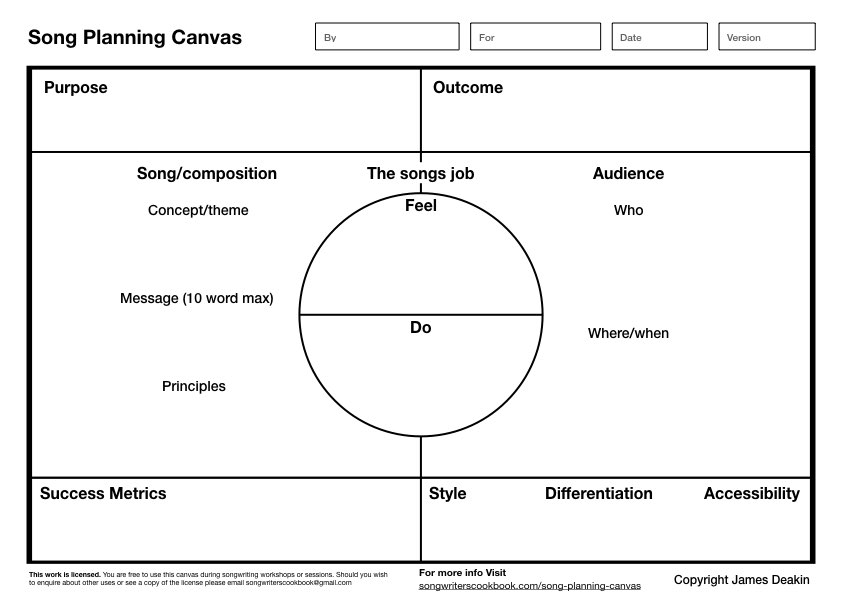Getting started
A beginning
Start with the end in mind
There’s an age old question in song writing “Where do I start?”. Do I write a riff, come up with some chords, a rhythm or a lyric? A better question to ask is “How will I make decisions?”.
The truth is it doesn’t much matter where you start. You might like the sound of a riff or a beat you have created and that’s great. You also might be inspired by some words you have written, again great. Start somewhere. Each of these elements will suggest others. A beat suggests a melodic rhythm and the feeling suggests some harmony choices. A lyrical phrase prompts a melody or a musical idea.
You can make writing and composing easier by defining your creative intent. If you know what you are trying to achieve you won’t waste time on lyrics and music that don’t help you achieve your objective. Song writing is an iterative process and you have to make lots of decisions along the way. Anything that makes those decisions easier will speed up and improve your song writing.
I like to think of the creative intent as the job the song will do for the audience. It’s the reason why people will fall in love with your song. Define it by answering the following five questions:
1. Which mood, moment or playlist will the song fit?
With the advent of streaming, playlists have replaced albums as the primary way of organising music. People use music to soundtrack their lives and they either select songs that fit the mood or moment or pick a playlists that fits. Great writers of the past have used this to their advantage. “Hey Jude” picks you up when you feel down. “Dancing Queen” helps people get on the dance floor. Where does your song fit in the sound track to peoples lives?
2. What strong emotion will your song evoke?
Great songs help the audience experience (and process) a strong emotion. If you analyse the lyrics to popular songs you will find four feelings pop up again and again. Two researchers at North Carolina State University found that four lyrical themes have dominated the Billboard’s Hot 100 chart for five decades.
Sadness/loss – “Love Will Tear Us Apart” by Joy Division, “You Oughta Know” by Alanis Morissette, “thank u, next” by Ariana Grande
Power – “Take the power back” by Rage against the machine, “Eye of the tiger” by Survivor, “Respect” by Aretha Franklin
Romance – “lets get it on” by Marvin Gaye , “Thinking Out Loud” by Ed Sheeran
Dancing – “Get Lucky” by Daft Punk, “Groove Is In The Heart” by Deee-Lite, “Can’t stop the feeling” by Justin Timberlake
People need to process these emotions and songs help them do so. The themes are well worn but writers and composers find new ways to express them.
3. Who are you writing for?
You may have a particular group of people in mind when you write your song. This may be important if they have a particular style or subculture. They may use different words or phrases and have a special outlook on life. Perhaps they belong to a movement and you want to connect your song to their themes.
4. What’s the purpose of the song/composition?
Is it a song for your band to play or a sound track for a TV show? Is it for a school play or destined for the top 10?
5. What outcome do you hope to achieve?
If you are looking to get thousands or millions or streams on Spotify it’s worth capturing that objective. Try to describe what you want the song to achieve clearly.
Capture your progress
Once you have answered these questions fill in the “purpose”, “outcome”, “audience” and “songs job” sections of my free song planning canvas. Yay! That’s one section filled in and your are on your way to a song.
Choose a style or genre for your song
To belong to a genre you need to use the norms of that genre. The clichés of a genre help us to access the piece of music. Research shows that hit songs strike the right balance between accessibility and novelty. The researchers say a song is ‘optimally differentiated’ when it’s familiar enough to engage with and different enough to sound new and stimulating.
Often songwriters overvalue originality and undervalue cliché. Don’t worry your song will have its own unique character even if if it uses some clichés. Once you have written the song you can decide make change if you feel you need to.
Capture your progress
Write down the style of song you are planning to make in the bottom right hand box of the song planning canvas. As you work on your song, notice which choices are normal for the genre and which ones are taking it somewhere new.

I greatly appreciate your clear and demanding approach. It’s just what I need!